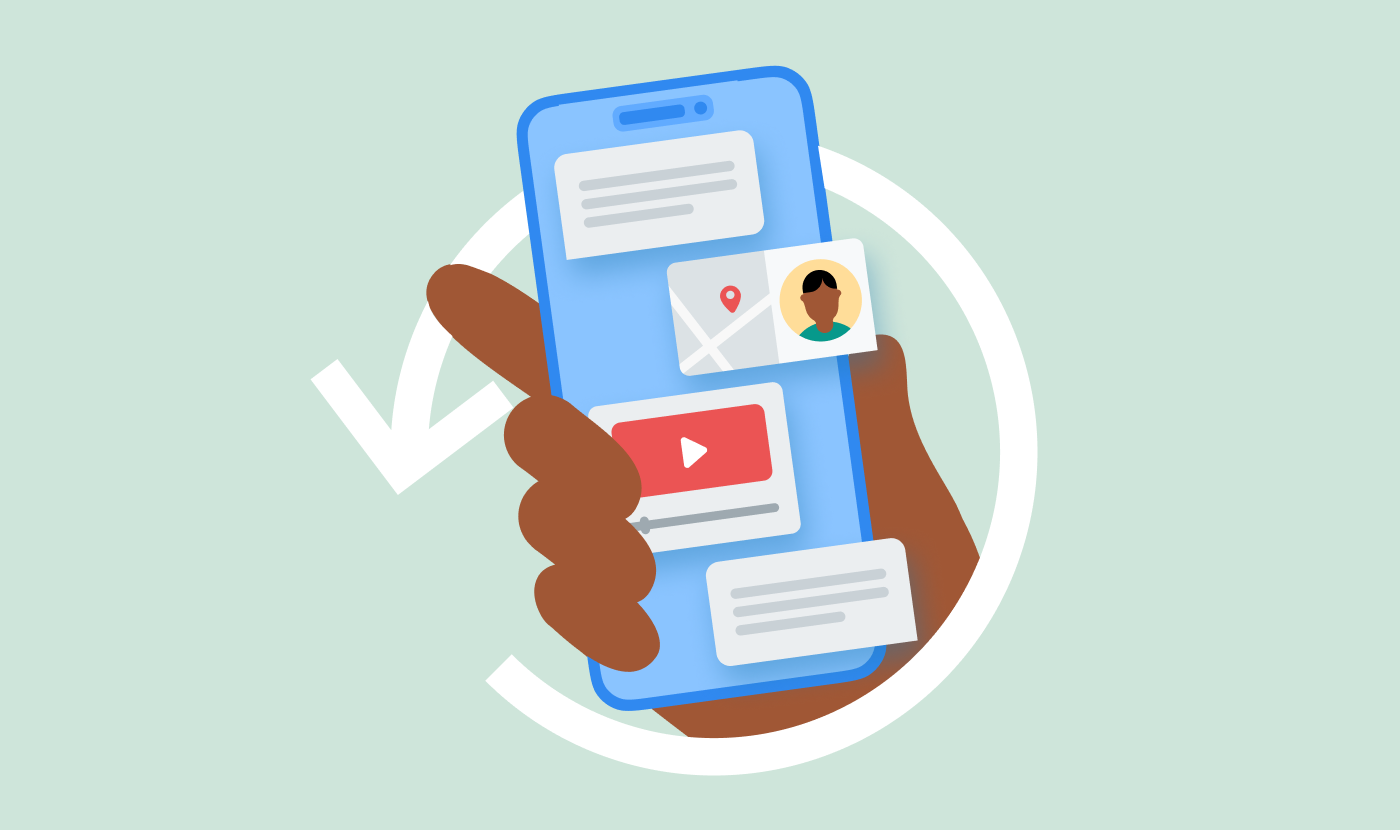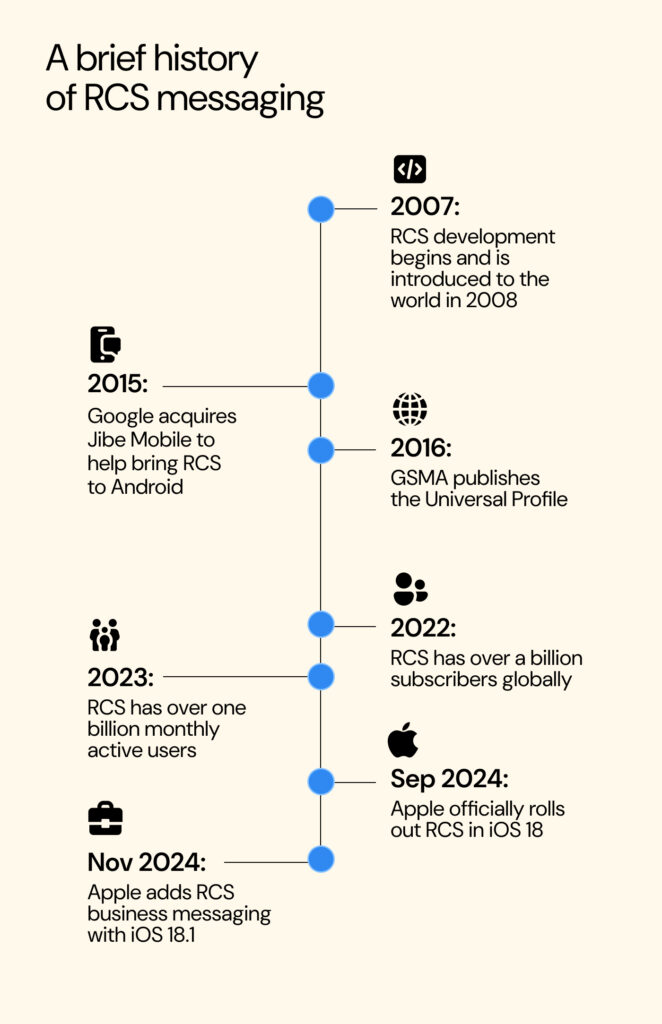Insights
A brief history of RCS messaging

Insights

Rich Communication Services (RCS) might be making headlines today with Apple finally rolling out support for both peer-to-peer and business messaging, but the story of the communication protocol started years ago. Its founding story is grounded in the race to modernize SMS, and how Google played a major role in shaping its future.
In 2005, Google acquired a small startup called Android for an undisclosed price (but estimated at $50 million). Over the next three years, Google transformed Android into a mobile operating system that would shape the future of smartphones.
Around the same time, mobile operators worldwide were looking to upgrade SMS, which had been the default messaging standard for years, to something that would better compete with over-the-top (OTT) channels. In 2007, they began developing RCS, which they envisioned as something that would handle images, videos, and had better security than traditional SMS.
The idea for RCS was simple: Take text messaging to the next level. But like all great stories, the road to success wasn’t without its challenges.

While text messaging had been around for decades, RCS messaging was introduced to the world in 2008. It was created by the GSM Association (GSMA) and a few major mobile operators to offer more features than SMS. At first, it wasn’t a messaging standard, but rather a set of tools that could be implemented in different ways, like for payments.
In early 2011, Europe’s five biggest mobile operators championed RCS by launching a service brand for a simplified version called “Joyn.” The idea was to roll out Joyn across Europe starting in 2012 as a solution to replace SMS, but it didn’t catch on widely. For years, RCS struggled to find its footing, and SMS remained the default way people sent text messages.
A turning point came in 2015 when Google acquired a company called Jibe Mobile, which specialized in RCS backend technology, to help bring RCS to its Android products. Mike Dodd, an Android Software Engineer at the time, told TechCrunch that this acquisition was done to help roll out RCS as a global messaging service.
We’re also very excited to announce that the Jibe Mobile team is joining Google to help us bring RCS to a global audience. Jibe is a leading provider of RCS services and they’ll continue helping carriers easily deploy RCS to their users. We can’t wait to work with them and build on the great work that they’ve already done.”
In November 2016, the GSMA published the Universal Profile, a set of guidelines that made RCS interoperable across carriers and easier for mobile operators to scale. This helped address one of the main challenges RCS had faced in its early years, which was ensuring compatibility across networks. And by 2020, Google was actively rolling out RCS chat on as Android’s primary texting platform.
By 2021, Samsung had adopted the Google Messages app as the default messaging app on its phones in some regions. And around the same time, U.S. mobile operators also dropped their independent RCS efforts to begin using Google’s system, making RCS more accessible than ever.
And by 2022, RCS had over a billion subscribers globally, a number that continues to grow. Today, most mobile operators rely on Google as a service provider to enable RCS on their network, and Google Messages has become the primary app where RCS messages appear on nearly all Android phones.
By this time, many notable brands had started to use RCS in creative ways, like for Picard’s holiday promotion in France. These campaigns showed how RCS could elevate customer interactions with branded, personalized communications.
Picard’s RCS campaign allowed for multimedia-rich, engaging, and personalized communications that resulted in a 42% increase in customer engagement vs other mobile messaging channels.
Someday, we’ll refer to 2023 and 2024 as the breakthrough years of RCS. By 2023, Google reported that RCS had over one billion monthly active users.
Then, the biggest news happened in November 2023 when Apple announced it would support RCS. For the first time, iPhone users would be able to use RCS to text Android users and vice versa, leading to a much better user experience than with SMS.
By this time, businesses had already started to take note. By mid-2023 RCS Business Messaging (RBM) adoption had grown 40% compared to the year before, far outpacing other messaging channels, and by November 2023, Sinch saw the number of RCS messages sent by brands had skyrocketed to 25,000 times more than in early 2022.
Apple officially rolled out RCS in iOS 18 in September 2024, making it easier for people on any device to connect. And later in 2024, Apple added RCS business messaging with iOS 18.1, allowing brands to reach iPhone users for the first time through this channel.
This continued to expand business’ reach and open doors for more interactive campaigns, and in 2024 Sinch saw an impressive 111% growth in messaging across Black Friday and Cyber Monday compared to 2023.
By the end of 2024, with support from both major operating systems and growing adoption by users and businesses, RCS is set to keep growing in the years ahead.
The future of RCS looks incredibly bright. In 2023, the global RCS market was valued at $8.37 billion, and it’s expected to more than double to $19.48 billion by 2028 according to a global market report by The Business Research Company.
Apple’s support for RCS in iOS is a big reason why, and some quick, back-of-the-napkin math may tell us why: Historically, over 50% of iPhone users upgrade to the latest iOS version within months, with adoption climbing to 80% the following summer. If iOS 18 follows this trend, and Apple continues to expand the markets that it supports RCS, it could add over one billion new RCS users by mid-2025, bringing RCS reach closer to messaging giants like WhatsApp.
For brands, this will mean in 2025 and beyond, they’ll be able to reach even more customers in a richer, more engaging way that lands right in their native mobile inbox. The potential for interactive campaigns, personalized multimedia messaging, and better customer experiences will only grow.
Sinch has been leading the way in RCS adoption, and the momentum we’re seeing now has been a long time coming. Brands are already using RCS to transform how they communicate with customers in exciting and innovative ways. We’re proud to have been at the forefront of this shift and are ready to help even more businesses deliver richer, more engaging, and interactive messaging experiences in the years to come.”

The stage is set for RCS to become a cornerstone of how we communicate in the years ahead.
RCS has come a long way since its early days in 2008, and with support from both Apple and Android devices, it’s finally living up to its promise of revolutionizing messaging. For businesses, this could mean the possibility to engage both iPhone and Android users through a messaging experience that’s interactive, engaging, and inherently personal.
Whether it’s with personalized campaigns, interactive customer experience, or simply a better way to verify consumers, RCS offers endless possibilities. Check out some of these resources to learn more about the potential with RCS:
Want to learn more? Download our guide to learn how to unlock the full potential of RCS and stay ahead in customer engagement.